Japanese Cooking 101, Lesson 1-Addendum: Making Miso Soup and Clear Soup with Dashi
Now that you know how to make a proper dashi, you're 90% on your way to making delicious miso soup and clear soup. If you have ever wondered why your miso soup doesn't taste quite right, and you were omitting the dashi part...you're in for a treat!
Basic miso soup (味噌汁, misoshiru)
For this lesson I will be using one ingredient, potato, that should be familiar to anyone, and another, wakame seaweed, which may be more unusual but is a standby in Japanese kitchen. It also gives me a chance to show you how to handle miso soup additions that have different cooking times.
A bit about wakame
Wakame (わかめ) is very different from kombu, but is probably the second most used seaweed in Japanese cooking. Unlike kombu wakame doesn't have a whole lot of umami, although it has a pleasant sea-flavor. It's enjoyed more for its texture, which can be kind of chewy and squeaky when raw, or soft once you cook it even briefly.
Wakame is available in two forms: fresh (raw) and packed in salt; or dried. I usually have the dried kind around because it's more convenient (especially when you live far away from a Japanese grocery store like me) and that is what I used here:
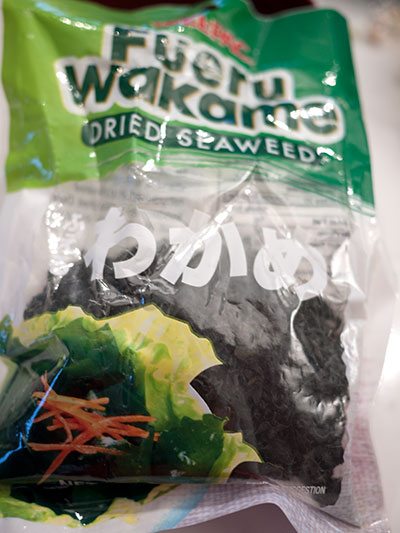
Dried wakame expands to 4-5 times its volume when reconstituted, so use sparingly. Dried wakame usually comes already chopped up, so all you need to do is to take out some and reconstitute in cold water is using in salads or side dishes. For soup you can just put it directly into the soup.
Fresh wakame packed in salt should be stored in the refrigerator. Before using, rinse off the salt under running water, then blanch briefly by pouring boiling water over it. If using in a salad, refresh in cold water. Fresh wakame comes in long whole strands, so you need to chop it up before using. It also expands a bit (about 1.5 times or so) so don't pull out more than you need from that tangle in the packet.
The miso I used, and how much to add to your soup
For this miso soup I used a white Shinshuu miso. Shinshuu is the old name of Nagano Prefecture, and is known for its excellent miso. It's fairly mild on the saltiness scale.
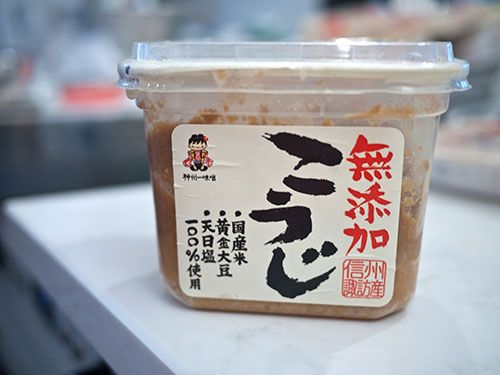
Every miso has a different level of salt, and the worst thing you want to do is to add too much miso to your soup. A general rule of thumb is to use about 1 tablespoon per cup (U.S. measure, 236.5ml) or 1/4 l (250ml) but if you have a very salty red miso for example, you may need less. So when you are trying out a new miso, always add less than you think you need. It's easy to add more. Since we'll be using 1000 ml / around 4 cups for this recipe, we'll start with 3 tablespoons and add more if we think we need it.
(See: Japanese miso primer for more about different types of miso.)
Potato and wakame miso soup (じゃがいもとわかめの味噌汁)
For 3-4 servings
- 1000ml / 4 U.S. cups dashi
- 1 medium potato, peeled and cut into small pieces
- 2-3 tablespoons of dried wakame, or 4-5 tablespoons (about 2 strands) of fresh wakame
- 3-4 tablespoons of miso
- Bring the dashi up to a boil, and add the potato. Lower to a simmer, and cook until the potatoes are soft, around 10 minutes depending on how big the pieces are.
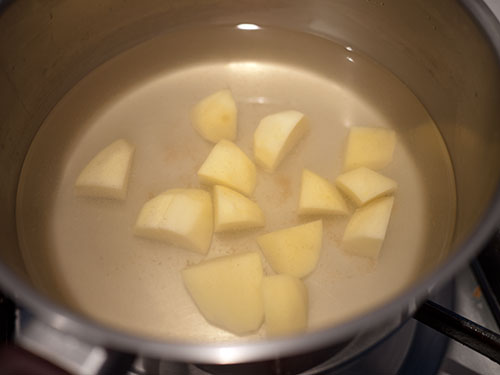
- In the meantime, if you're using fresh wakame, process it as detailed above. Dried wakame can just be thrown in there without reconstituting. When the potato pieces are tender, add the wakame.
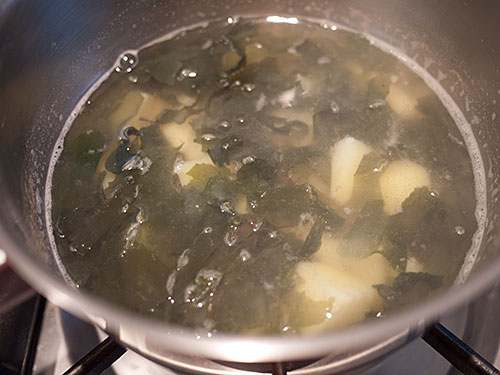
- Put the miso paste in a bowl and add some of the liquid from the soup.
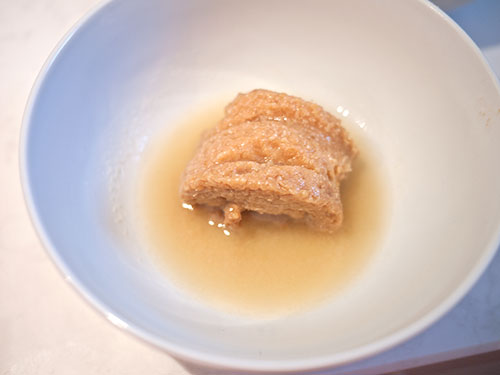
- Mix it around in the liquid until it's dissolved. Never add miso paste directly to soup: always dissolve it first. Otherwise you run the risk of salty clumps or miso in the soup, or of overcooking it. (Incidentally, I always do this dissolving part in the bowl of the ladle I'm using, as do most Japanese home cooks. Once you get more used to making miso soup you can try that too. Less washing up to do!)
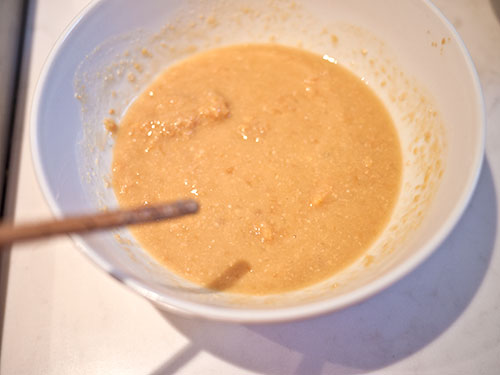
Add the dissolved miso to the soup, then immediately turn off the heat. Miso should not be boiled, or it starts to turn a bit grainy. (Mind you it will still taste fine, so if this happens to you don't throw away your soup or anything). Taste your soup, and if needed add a bit more dissolved miso.
Serve in a bowl. The combination of potato with soft wakame is really homey and delicious. Take your time to inhale the aroma of the soup. If you serve this to a homesick Japanese person they may cry in gratitude.

Tip: If you can't get wakame, you can use some shredded spinach (as I used in the clear soup below) instead.
Miso soup summary
- Cook any hard ingredients until tender in the dashi.
- Add no-cook or almost-no-cook ingredients at the end.
- Always dissolve the miso before adding to the soup, using some of the dashi in the pot.
- Add less miso than you think it needs, then add as needed. 1 tablespoon = 1 U.S. cup or around 250ml of dashi is a fairly good baseline, but all misos are different.
- Never let miso soup boil after adding the miso.
Variation: Clear soup (お吸い物 - osuimono or おすまし - osumashi)
Delicate clear soup or osuimono may seem even easier to make than miso soup on the surface, but getting the flavor balance just right can be a bit tricky. A clear soup really must have a great tasting dashi as a base. Many cooks prefer to use a kombu dashi which is more subtle and refined according to some, but the standard kombu + katsuobushi dashi is fine too.
Here I have used two ingredients that should be easy to get anywhere.
Chicken supreme (tenders) and spinach clear soup (鶏ささみとほうれん草のお吸い物 - tori sasami to hourensou no osuimono)
For 3-4 servings
- 1000ml / 4 U.S. cups dashi
- 1 teaspoon soy sauce (light soy sauce preferred, but dark is ok)
- 2 teaspoons sake
- 1 teaspoon mirin
- Salt to taste
- 1 chicken tender or supreme (the long, thin, tender part that's on the underside of a chicken breast), cut into small slivers
- 3-4 spinach leaves, stalks removed and shredded
I didn't include any step by step photos here since you'll just see a pan of clear liquid mostly! But here are the steps.
- Bring the dashi to a boil, then lower the heat to a simmer.
- Add the soy sauce, sake and mirin. (Note for people who can't use these ingredients - just leave them out; the soup will still taste pretty good.)
- Add the chicken, then add the spinach. Both will cook almost immediately.
- Taste the soup. Add a pinch of salt if you think it needs it, then taste again, until it has the right amount of saltiness.
- Serve in a bowl.

So there you have it! You know how to make great miso soup and clear soup!
If you would like to do so, please link to a picture of your results in the commencts right here, via Twitter to @justbento or @makiwi, or on the Facebook page.


 Welcome to Just Hungry, where we serve authentic Japanese recipes and more! I'm
Welcome to Just Hungry, where we serve authentic Japanese recipes and more! I'm 













Comments
Rasiel
7 March, 2013 - 00:03
Permalink
Re: Japanese Cooking 101, Lesson 1-Addendum: Making Miso ...
Thank you so much for posting this! I have been meaning to learn how to make miso soup and just bought some, but had no idea how to prepare it! Your site has taught me so much in the past month, my tastebuds had no idea what they were missing!
Sue Mosher
7 March, 2013 - 01:27
Permalink
Re: Japanese Cooking 101, Lesson 1-Addendum: Making Miso ...
So good I ate two helpings! I simmered a few buna-shimeji (beech mushrooms) and a sliced green onion with the potato. Great tip about using the ladle to dissolve the miso.
Judith
7 March, 2013 - 03:38
Permalink
Re: Japanese Cooking 101, Lesson 1-Addendum: Making Miso ...
Miso soup: The soup was terrific. I added some daikon with the potatoes and wakame.
Thank you, not only did the lesson provide a delicious supper, but I had fun too. I am learning to 'slurp'.
Chiaoli
7 March, 2013 - 07:45
Permalink
Re: Japanese Cooking 101, Lesson 1-Addendum: Making Miso ...
Thank you so much for posting this! A very quick question, if I put tofu (cut into small cubes) instead of potato in this miso soup, when should I put them in and how long for them to be cooked? I know tofu could be eaten raw, but I am not quite sure about all the details. Thanks again!
maki
7 March, 2013 - 10:33
Permalink
Re: Japanese Cooking 101, Lesson 1-Addendum: Making Miso ...
The tofu just needs to be heated through basically, so just add the wakame a couple of minutes after the tofu is added.
Katy K
7 March, 2013 - 15:42
Permalink
Re: Japanese Cooking 101, Lesson 1-Addendum: Making Miso ...
I imagine aburaage is treated like regular tofu here (after blanching, I mean.)
Thank you so much for all your wonderful advice!
maki
7 March, 2013 - 17:22
Permalink
Re: Japanese Cooking 101, Lesson 1-Addendum: Making Miso ...
Yep - aburaage just needs heating through also. (And as you said, after blanching with boiling water to get rid of the excess oil.)
Katie
7 March, 2013 - 20:24
Permalink
Re: Japanese Cooking 101, Lesson 1-Addendum: Making Miso ...
For people who are gluten free, you can find virtually gf miso -- I use Miko Brand shiro miso.
(image: http://www.theasiancookshop.co.uk/ekmps/shops/asiancookshop/images/miso-...)
It looks like it has the same icon as yours.. is it the same company?
(Miso is often made with barley or rye, and I worry it's contaminated. I'm very gluten-sensitive! :D) But I've had this brand a lot and other GF people I know are ok eating it.)
maki
10 March, 2013 - 02:30
Permalink
Re: Japanese Cooking 101, Lesson 1-Addendum: Making Miso ...
It doesn't look like the same brand to me, but should be fine. Glad you found a good gluten-free miso for you!
Naomi H
8 March, 2013 - 02:44
Permalink
Re: Japanese Cooking 101, Lesson 1-Addendum: Making Miso ...
I am so thrilled to have found your website. I grew up eating my mom's Japanese cooking, but much to her dismay I was never interested in cooking it. She will be floored when I tell her I made dashi from scratch! I never had miso soup with potatoes - I like it! I also added tofu at the end, and it made a delicious dinner. This miso soup brought back lots of childhood memories. Thank you!
BarbJ
8 March, 2013 - 04:19
Permalink
Re: Japanese Cooking 101, Lesson 1-Addendum: Making Miso ...
Oh, so goooood! I only had wakame (we ended up eating the potatoes I bought for this class a couple days ago, :/) but it was still so good. I actually like very plain miso soup so that was fine.
Also, I sometimes make miso soup the morning after imbibing a little too much, and something about it soothes my sorry tummy. Well or ill, can't have too much miso!
Wondering
8 March, 2013 - 08:37
Permalink
Re: Japanese Cooking 101, Lesson 1-Addendum: Making Miso ...
What about if my miso is "dashi iri" (dashi already included)? Should I just use water as my base liquid?
maki
10 March, 2013 - 02:26
Permalink
Re: Japanese Cooking 101, Lesson 1-Addendum: Making Miso ...
Even with dashi added miso, the miso soup will taste a lot better if you make dashi. Keep in mind that most dashi-added miso is artificial dashi-added, and usually contains MSG. You may want to be extra careful about not adding too much miso at first, and adding more later after tasting.
missmochi
8 March, 2013 - 09:07
Permalink
Re: Japanese Cooking 101, Lesson 1-Addendum: Making Miso ...
I love miso soup with wakame and potatoes. It's very comforting for me, and great as a feeling-the-blues pick me up when I'm depressed.
One thing, for your clear soup recipe, you state "Many cooks prefer to use a kombu dashi which is more subtle and refined according to some, but the standard wakame + katsuobushi dashi is fine too."
But I think you mean "kombu + katsuobushi dashi is fine too"
Normally I wouldn't bother pointing out the error since I know what you meant, but I figured since this is a primer for beginners I should say something.
Thanks for reminding me of this great combo. I will have to grab some potatoes from the market!
maki
10 March, 2013 - 02:27
Permalink
Re: Japanese Cooking 101, Lesson 1-Addendum: Making Miso ...
Oops you're right - corrected now. Thanks for pointing that out!
flasun
8 March, 2013 - 19:39
Permalink
Re: Japanese Cooking 101, Lesson 1-Addendum: Making Miso ...
WOW, what a wonderful wakame potato soup. Thank you very much for a delightful lunch. It's nice to have the other comments as well for additional ideas to the soup.
I'm very excited about this class. Thank you for presenting it.
Levynite
8 March, 2013 - 20:49
Permalink
Re: Japanese Cooking 101, Lesson 1-Addendum: Making Miso ...
"Every miso has a different level of salt, and the worst thing you want to do is to add too much miso to your soup. A general rule of thumb is to use about 1 tablespoon per cup (U.S. measure, 236.5ml) or 1/2 l (250ml) but if..."
Can I point out that 250ml =/= 1/2 l? It's 1/4 l, I believe. 500 ml is half a litre.
maki
10 March, 2013 - 02:31
Permalink
Re: Japanese Cooking 101, Lesson 1-Addendum: Making Miso ...
Urgh, another typo. Corrected now!
John Corbally
9 March, 2013 - 01:15
Permalink
Re: Japanese Cooking 101, Lesson 1-Addendum: Making Miso ...
I have just come down with a nasty cold, and I was curious if either of these soups can be helpful chasing that away (the way that chicken soup supposedly is).
The miso is delicious, and I am going to make the clear soup tomorrow. I was just wondering if there were any health benefits (rumored or otherwise); really, I am hoping they will help me get rid of this cold.
:)
maki
10 March, 2013 - 02:13
Permalink
Re: Japanese Cooking 101, Lesson 1-Addendum: Making Miso ...
If you add a lot of vegetables to your miso or clear soup you'll be getting a lot of vitamins in a hot soup - which I think is the main reason why chicken soup is considered to be so good for you when you have a cold. You can try for instance shredded cabbage, simmered until tender in the dashi, with the miso added later; shredded daikon treated in a similar way, etc. I hope you feel better soon!
Melanie
9 March, 2013 - 01:59
Permalink
Re: Japanese Cooking 101, Lesson 1-Addendum: Making Miso ...
I just made the miso with potato and wakame and also the clear soup using tofu and mizuna. They are both so delicious!
Is there a trick to being able to cut up soft/silken tofu without turning into a big smooshy mess? I got the Morinaga kind because I like using their firm style for other cooking, but I made a HUGE mess of it! Still tastes good, but it isn't pretty...
maki
10 March, 2013 - 02:33
Permalink
Re: Japanese Cooking 101, Lesson 1-Addendum: Making Miso ...
The trick is to wet your cutting board first - it should be dripping wet really - and to cut your tofu on the wet board. It should then slide into your soup smoothly. Another way, which is a bit more dangerous, is to cut the tofu on your wet hand, which you can then just empty out into the pot. But be careful not to add a bit of your hand in the process!
Melanie
10 March, 2013 - 02:47
Permalink
Re: Japanese Cooking 101, Lesson 1-Addendum: Making Miso ...
I will try that, thank you! :)
Marcin
9 March, 2013 - 14:10
Permalink
Re: Japanese Cooking 101, Lesson 1-Addendum: Making Miso ...
Thank you so much for writing this series. I've already tried cooking some Japanese dishes (curry, tamagoyaki, onigiri) but I wanted to learn more about the fundamentals. I couldn't find anything sufficiently basic; this, however, is perfect. Your very detailed instructions and explanations are perfect for a washoku newbie like me. I made the potato and wakame miso soup today and it turned out fantastic. I've never eaten miso soup before, so don't know if it tasted right but I really liked it.
I must admit I was a bit worried before trying this recipe. I thought I might not like it after all — the only ingredient I was familiar with was potato; I haven't really eaten seaweed other than nori in sushi before; and fish-based stock sounded possibly too fishy to me — but I was proved wrong. I used the kombu + katsuobushi dashi and was surprised by how good it tasted. Very pleasant, with only a little touch of fish. Also, making it is remarkably easy. The final soup has me craving more. I'm really looking forward to the next lessons!
Ellen W
10 March, 2013 - 00:07
Permalink
Re: Japanese Cooking 101, Lesson 1-Addendum: Making Miso ...
The miso soup was delicious! I have been making miso soup poorly for over 30 years. Your instructions are clear and the results are what I've been looking for. Looking for to trying the clear soup with the next batch of dashi.
LoriR
10 March, 2013 - 01:50
Permalink
Re: Japanese Cooking 101, Lesson 1-Addendum: Making Miso ...
I've tried a different version of making miso soup before, but I like this one better. It sounds (and tastes!) like more flavor is extracted from the kombu, and less bonito flakes are used compared to the recipe I have used in the past, which I also like. I have never considered using only wakame and potatoes before for a simple miso soup! It's very good! I added mushrooms and cherry tomatoes to mine. I've tried making a clear soup before, but it didn't turn out very well :( I'm going to try my hand with the recipe here as well :) Thank you very much for these recipes! Looking forward to what's next! :D
Ingrid
10 March, 2013 - 23:22
Permalink
Re: Japanese Cooking 101, Lesson 1-Addendum: Making Miso ...
Thanks for posting this course. I gave the dashi and different soups a try and documented the results on my blog tonight (http://sugarandspicetales.blogspot.be/2013/03/japanese-cooking-101-miso-...).
I ended up using too many ingredients though and therefore the soups were not as pretty, although tastewise they were a success.
Oh and thanks for the tofu cutting trick you gave to Melanie. I have always had badly cut tofu (the mooshy mess) and had come to terms with the fact that I would never have an visually pleasing result. I'll try the wet board technique next time. ^_^
Looking forward to the next instalment of the cooking series.
anon.
11 March, 2013 - 02:38
Permalink
Re: Japanese Cooking 101, Lesson 1-Addendum: Making Miso ...
Made the miso soup with wakame and potato. Delicious! I used a red miso and was mindful of how much to use since it's stronger than white. I loved the potato in the soup. The only drawback is I used up all of the dashi and now have to make more!
Megsie_k
11 March, 2013 - 03:59
Permalink
Re: Japanese Cooking 101, Lesson 1-Addendum: Making Miso ...
I normally use a small sieve held in the dashi when dissolving the miso as there are bits of sediment in some miso pastes.
maki
11 March, 2013 - 19:23
Permalink
Re: Japanese Cooking 101, Lesson 1-Addendum: Making Miso ...
The sediment in miso is usually some bits of soy bean and so on so it's not totally necessary to strain them out, unless you're aiming for a very smooth miso soup.
Lynn
11 March, 2013 - 05:22
Permalink
Re: Japanese Cooking 101, Lesson 1-Addendum: Making Miso ...
Thank you so much for the cooking lessons!
I love miso soup, but have never been able to successfully make it until today. Success at last! I had all of the right ingredients before, but I did not know how to to use or make dashi.
And even better, you showed me that msg is not needed. Every time I asked someone how to make miso soup they would always start with msg, which I prefer not to use.
Thanks again! I could easily eat this every day.
Heda
11 March, 2013 - 11:58
Permalink
Re: Japanese Cooking 101, Lesson 1-Addendum: Making Miso ...
I took a big bowl of miso soup with potatoes. carrot, reconstituted dried shiitake mushrooms, tofu and wakeme to work today for lunch. Delish even if I say so myself. When I heated it in the microwave it was like being instantly transported to Japan. Thank you.
Annie
12 March, 2013 - 17:10
Permalink
Re: Japanese Cooking 101, Lesson 1-Addendum: Making Miso ...
Made miso soup for breakfast this weekend. Picture on Flickr: http://www.flickr.com/photos/emilyspinach/8552293984/
Ishy
12 March, 2013 - 17:51
Permalink
Re: Japanese Cooking 101, Lesson 1-Addendum: Making Miso ...
I had a photo, but I accidentally deleted it. Mine was pretty simple miso, with just the wakame as an accent. Anyway, I made the miso soup, and it came out wonderfully. I definitely noticed the complexity of flavors when compared to what I've had in restaurants before.
Bonniemiso
12 March, 2013 - 23:09
Permalink
Re: Japanese Cooking 101, Lesson 1-Addendum: Making Miso ...
As a miso-obsessive, I am so impressed with this blog post - thank you for sharing!
frankncents
13 March, 2013 - 06:07
Permalink
Re: Japanese Cooking 101, Lesson 1-Addendum: Making Miso ...
I often take miso soup to work as part of my lunch, but it never tastes as good as the (packet) soup my mother made growing up. The batch I made tonight with my homemade vegan dashi was so delicious, I slurped up two bowls with dinner! I added some dried shiitakes, and a healthy dose of wakame. Thank you for such clear directions, I will definitely be adding dashi and homemade miso soup to my cooking repertoire.
Silvia.
13 March, 2013 - 13:11
Permalink
Miso and clear soup
Miso *_* I will absolutely try this!!! The first time I had miso soup was more than 10 years ago, my sister brought back from Japan instant miso packets and we had them every day for a week or more!!! I wanted to know if the clear soup and the miso soup recipea are good for udon too. Can I cook the udon noodles and then add them to the soup? :)
Katie
15 March, 2013 - 08:14
Permalink
Re: Japanese Cooking 101, Lesson 1-Addendum: Making Miso ...
This looks incredibly delicious! I'm sorely tempted to go buy more miso to make some tonight!
To everyone that adds the dried shitake, how do you add them? Whole? Chunked? Sliced?
Nancy
15 March, 2013 - 17:19
Permalink
Re: Japanese Cooking 101, Lesson 1-Addendum: Making Miso ...
I tried to make the miso soup last Sunday. I prefer it with more ingredients, so I used fresh and fried tofu, fresh shiitake, wakame, and green onions. Lo and behold, when I went to go add the miso, I couldn't find it in the fridge. Then the hubby reminded me that we used it up last time (months ago), but I didn't buy any for this assignment because I forgot about that fact!!! What to do, what to do?! Thanks to Maki's clear soup recipe, I used the seasoning combo from that of soy sauce, sake, and mirin, plus salt and some sugar, and it turned out great! :D Hubby said the broth reminded him of the sauce from agedashi tofu but as a soup, and we both loved it! I still want to do the actual miso soup, but thanks so much Maki for sharing recipes that are so tasty and versatile! :)
LizW
20 March, 2013 - 22:15
Permalink
Re: Japanese Cooking 101, Lesson 1-Addendum: Making Miso ...
Slightly late to the party on this one, but made miso soup... I've never had it with potato in before. I made quite a poor job of it... way too much miso.
(I followed the guideline, but for some stupid reason had forgotten to put a lid on the pan while the potatoes cooked, so the liquid had evaporated, and there was less than I thought... Duh!)
It was ok, but could definitely be improved - think I've probably overcooked miso previously, so definitely going to have another go soon. Also never heard the tip about dissolving it separately before, so thank you for that!
http://www.flickr.com/photos/9043927@N05/8576069620/in/photostream/
EnaKate
22 March, 2013 - 18:41
Permalink
Re: Japanese Cooking 101, Lesson 1-Addendum: Making Miso ...
Thank you for this yummy miso soup recipe. It worked out perfectly :-)
TedG
22 March, 2013 - 22:12
Permalink
Re: Japanese Cooking 101, Lesson 1-Addendum: Making Miso ...
Thank you for this great series. I thought I was way late finding your website but have just realized that I'm up-to-date.
I found a local Japanese retailer, the owner once a sushi chef, that helped me select the proper ingredients.
I made your Dashi & Miso soup last week when I 1st found your website, and have made it twice since then. I love miso soup, and Japanese food in general, and yours (now mine) is the best I've had (I've also learned how to adjust the recipe for my taste).
Just made your rice recipe which is also great. But I'm looking forward to future lessons when I can learn to put a full meal together.
Hope you find good health to be able to continue teaching us.
Thank you very much!!!
Ted
anon.
12 April, 2013 - 03:09
Permalink
Re: Japanese Cooking 101, Lesson 1-Addendum: Making Miso ...
Hi! :) I know I'm a little late to the Japanese Cooking 101 party, but I just made dashi stock, and it was great! Wasn't scary at all.
Now, I'm thinking of making miso soup, but I'm wondering: can you freeze miso soup to have for later if you're not supposed to boil miso?
I'm trying to find ways to pre-make my meals so I don't have to worry about them during the week, and pre-made homemade miso soup would be excellent! However, if you're not supposed to cook miso because it gets grainy, then maybe I should wait until I'm hungry to turn my dashi into misoshiru...
Thank you! :) I can't wait to get further into the 101 course!
Mawb
14 May, 2013 - 21:49
Permalink
Re: Japanese Cooking 101, Lesson 1-Addendum: Making Miso ...
I just finished eating a miso soup I made based on this recipe and using your dashi recipe too. It was wonderful!
For the record, I made it as a main course with white miso, carrots, chestnut mushrooms, broccoli florets, wakame seaweed, and firm silken tofu. I added some chopped spring onions just before serving and a tiny pinch of dried chilli flakes while cooking because today was cold, wet and miserable.
It was lovely - thank you for inspiring me to try and make my own Japanese food from scratch until I get the chance to go there again! Between your site and some great recipes from a friend I feel I am learning a lot about the flavours and ingredients.
Michael
13 July, 2013 - 11:07
Permalink
Re: Japanese Cooking 101, Lesson 1-Addendum: Making Miso ...
Im looking for a good asian food store online to buy some asian products. I want some seasoned dried seaweed, miso soup base....and other things. Thank you for your time sincerely Michael
maki
16 July, 2013 - 06:51
Permalink
Re: Japanese Cooking 101, Lesson 1-Addendum: Making Miso ...
Take a look at the Worldwide Japanese food shopping guide and look at the section for your region.
Deborah
19 July, 2013 - 23:43
Permalink
Re: Japanese Cooking 101, Lesson 1-Addendum: Making Miso ...
Hi Maki! Longtime lurker. (^_^)/ I had a question about reheating miso while retaining the health benefits.
I like to make a very hearty version for my lunch, it often includes a lot of ingredients like tied konbu, carrots, daikon, tofu, baby taro, renkon & gobo all in one batch. It's more like a miso stew, lol. Since it's a lot of chopping up & simmering, I usually create a batch that is large enough for 5 days or so. After everything is cooked, I make sure that the soup is barely simmering & I add the miso & then let it cool down & store it in the fridge. The next day I microwave a small bowl's worth (making sure the water doesn't get very hot) & add the wakame, green onion & greens. Do you think that either the storing or the microwaving destroy the health benefits of the miso?
maki
19 July, 2013 - 23:57
Permalink
Re: Japanese Cooking 101, Lesson 1-Addendum: Making Miso ...
I don't think either destroys the beneficial flora in the miso. However, storing may dissipate the flavor and fragrance of the miso a bit. You could try storing the basic simmered soup, then adding some miso just before you eat it (just dissolve it with some of the heated soup).
Enola Knežević
9 March, 2014 - 15:12
Permalink
Re: Japanese Cooking 101, Lesson 1-Addendum: Making Miso ...
I didn't have any wakame, so I made arame and potato miso soup. It's delicious! I used kombu-shiitake dashi, shiro miso and barley miso. It never occurred to me before to use potatoes in miso soup. I really like the combination.
anon.
17 April, 2014 - 00:35
Permalink
Re: Japanese Cooking 101, Lesson 1-Addendum: Making Miso ...
Am I supposed to add the raw chicken right into the clear soup broth? Is that okay? Or will Salmonella Fitzgerald be performing in my guts tonight?
maki
18 April, 2014 - 00:11
Permalink
Re: Japanese Cooking 101, Lesson 1-Addendum: Making Miso ...
Read again. The chicken is cooked in the soup.
anon.
18 April, 2014 - 05:32
Permalink
Re: Japanese Cooking 101, Lesson 1-Addendum: Making Miso ...
That's what I ended up doing and it turned out great. I'm just overly cautious with chicken. Thanks for the great recipes and for the course!
M
6 May, 2014 - 05:25
Permalink
Re: Japanese Cooking 101, Lesson 1-Addendum: Making Miso ...
Hi!
I was thinking the other day, I am not sure what it was that I was reading about enzymes and fermentation, that if you boil the miso, you kill the bacteria that is so beneficial. Perhaps this is another reason why you don't want to boil the soup once you added the miso paste?
M
Cat
4 November, 2014 - 21:44
Permalink
Re: Japanese Cooking 101, Lesson 1-Addendum: Making Miso ...
I love your site, and it is my go-to for anything Japanese cuisine related. I can't thank you enough!
I was wondering what your comment about soy sauce meant in the ingredients of the clear soup; do you mean that light is preferred but the other common types will work, or that specifically light and dark soy will work, but standard soy is not recommended? I found out the hard way once that dark soy is not regular soy when I bought a gigantic bottle and it was not what I expected.
I'm a web designer, so I noticed an oddity in the markup of this page: the numbers in the steps of the potato-wakame miso keep restarting.
Try putting everything in each step into a container of some kind (like a 'div', if Drupal will let you) so that the numbering doesn't start over. You should have my email from the comment form, so feel free to ask me any questions about html stuff. Just trying to give back. ^_^
Daniel
2 December, 2014 - 12:11
Permalink
Re: Japanese Cooking 101, Lesson 1-Addendum: Making Miso ...
Great guide for beginners it helped me a lot thanks.
Steve Matsukawa
1 June, 2015 - 01:51
Permalink
Doomo Arigatogozaimashite
America is a very difficult country to get Japanese style cooking ingredients. Other than the Southern California area, getting items such as teriyaki, sukiyaki and shabu shabu beef is very difficult. The butchers here in Schuylkill county, PA don't have a clue of what I am talking about.
The one time I tried I got chipped beef, not exactly what I needed. WalMart does have some items in their 'Chinese' department. Finally found a couple of online Japanese stores, expensive but at least you can get Nihonshoku.
So I either have to put up with Governor 'Moonbeam' Brown or buy online at prices just slightly higher than a giraffe's Adam's apple.
Sigh, sometimes life is just not fair.
But thank you so much for bringing my childhood favorites back to life. Okayu with umeboshi is great comfort food!